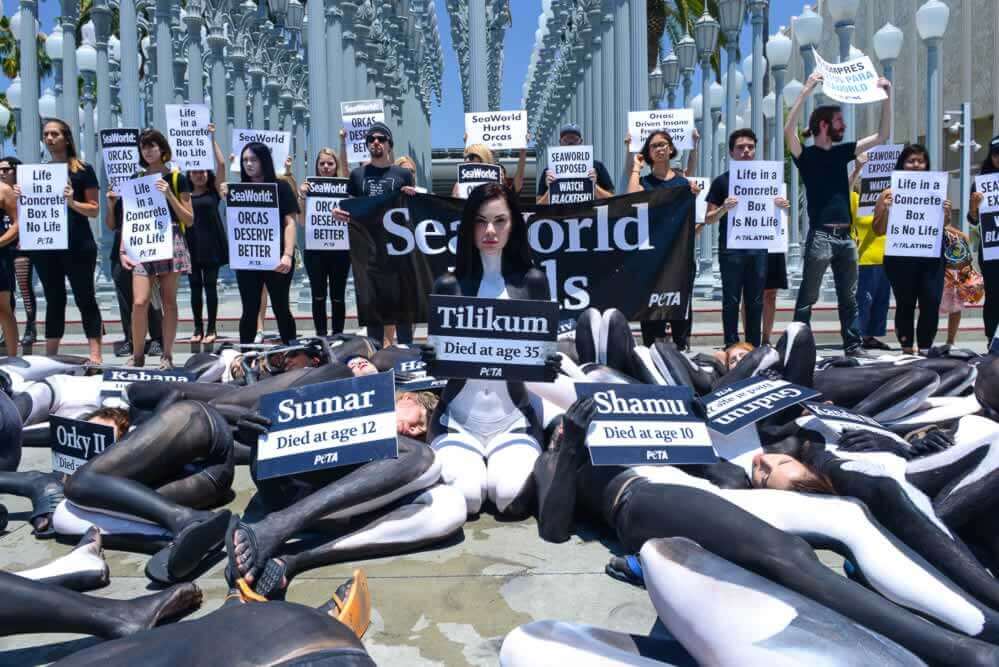SeaWorld’s reputation has long been under fire, but in 2025, the marine park operator finds itself embroiled in a growing storm of lawsuits, government investigations, and escalating protests from animal welfare advocates. From environmental violations in California to workplace safety violations in Florida, the company’s troubles have intensified—while animal rights groups continue to shine a spotlight on the dark realities of dolphin and orca captivity.
For years, activists have exposed the truth behind dolphin and whale confinement, highlighting the devastating psychological and physical toll captivity takes on highly intelligent marine mammals. SeaWorld’s legal entanglements and public controversies this year only reinforce a critical message: the era of keeping dolphins and whales in tanks for entertainment must come to an end. Learn more about dolphins in captivity here.
Legal and Environmental Battles
Clean Water Act Lawsuit in California
In March 2025, San Diego Coastkeeper and the Coastal Environmental Rights Foundation (CERF) filed a federal lawsuit accusing SeaWorld San Diego of violating the Clean Water Act. The lawsuit alleges that the park discharged harmful pollutants, including copper and contaminated wastewater from animal tanks, directly into Mission Bay.
Divers for CERF also reported alarming findings beneath the bay’s surface: fireworks debris scattered across the seafloor, remnants of SeaWorld’s nighttime shows. For local communities that depend on Mission Bay’s health, these revelations raise urgent concerns about the park’s ongoing environmental footprint.
OSHA Violation in Florida
SeaWorld Orlando’s troubles deepened in March 2025 when the Occupational Safety and Health Administration (OSHA) fined the park for violations tied to employee safety. The action stemmed from a September 2024 incident where an orca injured a trainer during a close-contact session. OSHA investigators concluded that SeaWorld failed to adequately protect employees from hazards associated with direct interactions with the massive whales.
This is not the first time SeaWorld has faced scrutiny for workplace safety. The park’s history of orca-related trainer injuries has long been cited as evidence of the inherent danger of keeping apex predators in captivity.
Protests and Animal Rights Campaigns
Boycott SeaWorld Day
Animal rights groups are keeping the pressure on in 2025. In July, PETA and the Animal Rights Foundation of Florida organized large-scale “Boycott SeaWorld Day” protests across the company’s parks in Orlando, San Diego, and San Antonio. Demonstrators reminded visitors that more than 400 dolphins have died at SeaWorld facilities since the parks opened, condemning both its captive breeding programs and the premature deaths of marine mammals under its care.
Celebrity Advocacy
Celebrities continue to amplify the cause. In April 2025, activist and entertainer Steve-O marked the anniversary of his daring 2021 protest by posting a video urging SeaWorld to end orca breeding permanently. Just a few months later, actress Lala Kent joined forces with PETA in a July campaign criticizing SeaWorld’s separation of dolphin calves from their mothers—a practice widely condemned by marine scientists and animal welfare advocates.
The Fight for Corky
No case better illustrates the tragedy of marine mammal captivity than that of Corky, the world’s longest-held captive orca. Corky has spent more than 55 years in a tank at SeaWorld San Diego, far from the natural rhythms of her family pod. Throughout 2025, PETA has continued its “Run for Corky’s Freedom” relay and related efforts to demand her release to a seaside sanctuary. Advocates argue that after decades in confinement, Corky deserves the chance to live out her remaining years in a more natural environment.
Local Community Opposition
SeaWorld’s battles are not limited to animal rights organizations. In San Diego, local community members have also taken a stand against the park’s controversial fireworks displays. In September 2024, the Mission Bay Parks Committee voted unanimously to recommend modifying or even eliminating SeaWorld’s fireworks shows, citing their impact on wildlife and noise pollution for surrounding neighborhoods.
This pushback underscores how SeaWorld’s operations affect not just its animals but also the broader environment and quality of life for nearby residents.
Class Action Lawsuit Over Annual Passes
Adding to its growing list of legal challenges, SeaWorld San Diego settled a $1.5 million class action lawsuit in May 2025. The case centered on its automatic annual pass renewal policy, which plaintiffs argued violated California consumer protection laws by failing to provide adequate notice of renewal terms. The settlement covered pass holders between February 2019 and February 2025.
While the case did not directly involve animal welfare or environmental concerns, it highlighted a broader pattern of questionable business practices that have only fueled distrust toward the company.
A Company Under Siege
Taken together, these developments paint a troubling picture for SeaWorld in 2025. Environmental lawsuits, workplace safety fines, community pushback, and relentless animal rights campaigns are converging to keep public scrutiny high. At the heart of it all is a growing acknowledgment that dolphins and whales suffer profoundly in captivity—living lives that bear little resemblance to their natural existence in the wild.
The mounting pressure begs the question: how long can SeaWorld continue to operate under a model that so many communities, experts, and advocates reject as outdated and inhumane? For sustainable action to move forward, the answer must involve reimagining marine parks without the exploitation of captive animals.
To understand the truth about the toll captivity takes on dolphins and other marine mammals, visit this resource on dolphins in captivity.
Conditions in captivity
- Confinement and stress: Animal welfare advocates argue that SeaWorld’s tanks are far too small for highly intelligent, social animals like orcas, who can swim up to 100 miles a day in the wild. This limited space can lead to stress, boredom, and repetitive behaviors.
- Abnormal behavior: The psychological stress of confinement can lead orcas and other marine animals to exhibit neurotic and aggressive behaviors, such as chewing on concrete and metal gates, which can damage their teeth. In some cases, the frustration has resulted in aggression toward other animals and trainers.
- Physical health problems: Captive marine animals often suffer from health issues uncommon in the wild. For example, all adult male orcas at SeaWorld have collapsed dorsal fins, which advocates attribute to a lack of deep-water diving and strong currents.
- Dolphin forced breeding: Following a public outcry, SeaWorld ended its orca breeding program in 2016. However, it continues to forcibly breed other dolphins and whales, a process criticized as sexually abusive by animal rights groups like PETA.
- Trainer injuries: Despite increased safety measures since the death of trainer Dawn Brancheau in 2010, the risks of working with captive orcas persist. In March 2025, SeaWorld Orlando was cited and fined by OSHA after an orca injured a trainer during a “training exercise”.
Dubious conservation claims
- Profit over welfare: Critics argue that SeaWorld prioritizes entertainment and profit over animal welfare, despite promoting itself as a conservation-focused organization. Conservation groups point out that keeping animals in tanks for shows, including a “new” orca encounter show, contradicts a mission of protecting wild animals.
- Misleading education: Activists assert that animal shows and “touch tanks” misrepresent marine animals’ natural behaviors and habitats. They argue that true conservation focuses on protecting animals in their natural environments rather than displaying them in artificial ones.
Alternatives to SeaWorld
Those who oppose SeaWorld’s practices often suggest alternatives for viewing marine life ethically:
- Whale-watching tours: Observe orcas and other marine mammals in their natural habitat through tours in places like the San Juan Islands or the Florida Keys.
- Wildlife sanctuaries: Support organizations that provide rescued animals with more natural coastal sanctuary habitats.
- Ethical aquariums: Some aquariums operate as non-profits and focus on genuine rehabilitation and scientific research, though not all animal exhibits are without controversy.
- Documentaries: For those wanting a deeper understanding of marine life without supporting captivity, documentaries like Blackfish and others offer an alternative learning experience.


